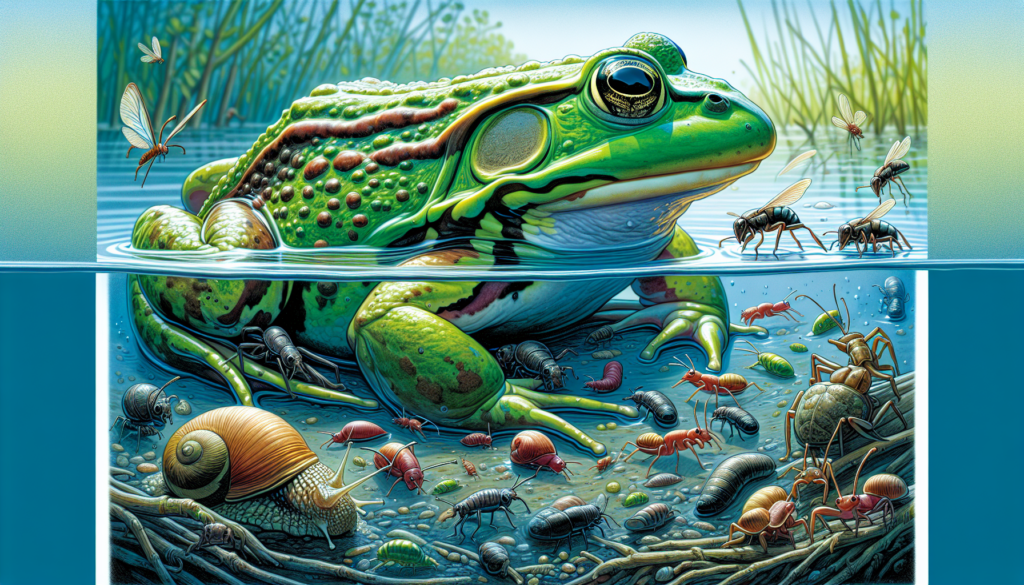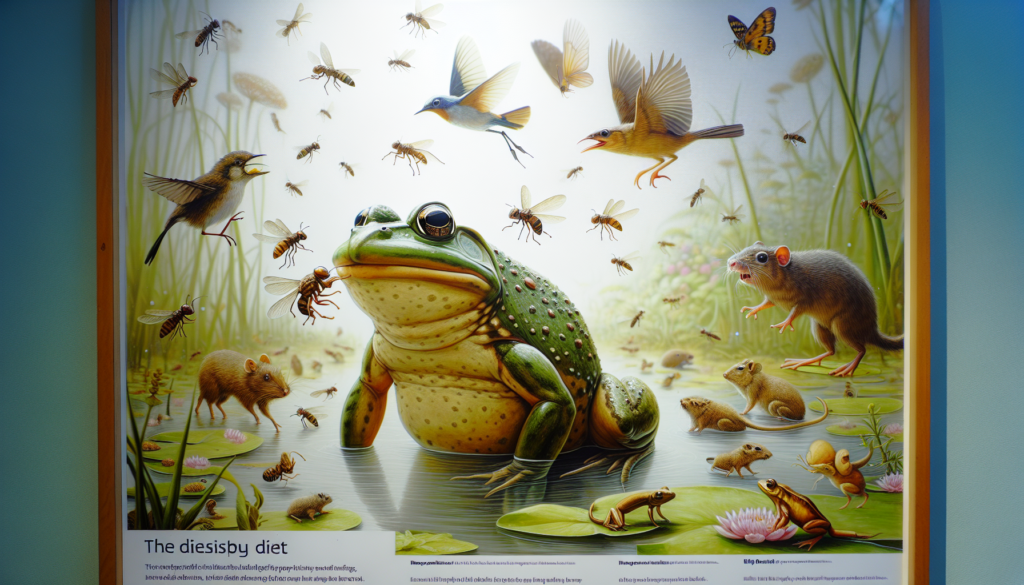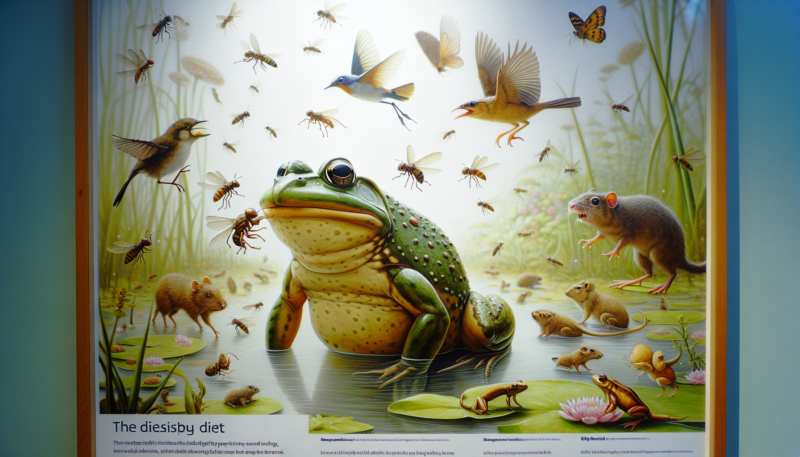Have you ever wondered what bullfrogs feast on in their slimy, lily pad-decorated homes? Fascinating and mysterious creatures, bullfrogs have a rather diverse palate that may surprise you. From insects to small mammals, these amphibians are skilled hunters, always ready to indulge in a hearty meal. Join us as we uncover the intriguing world of the bullfrog’s diet and explore the delightful array of delicacies that keep these amphibious creatures satisfied. Prepare to be amazed by their voracious appetite!
Types of Food
Bullfrogs have a diverse diet that consists of various types of food. These include insects, fish, amphibians, small mammals, and birds. Each of these food sources plays a crucial role in the bullfrog’s diet and provides the necessary nutrients for their survival.
Insects
Insects form a significant portion of the bullfrog’s diet. They feed on a wide range of insects, including beetles, flies, mosquitoes, and grasshoppers. The bullfrog’s strong jaw allows it to capture and consume these small creatures efficiently. Insects provide a rich source of protein and other essential nutrients for the bullfrog’s growth and development.
Fish
Fish also feature prominently in the bullfrog’s diet. Bullfrogs are skilled predators, often found lurking near bodies of water, waiting for an opportunity to strike. They feed on fish species such as minnows, sunfish, and even smaller bullfrogs. Fishing techniques may vary, but bullfrogs primarily rely on their speed and agility to catch their prey. By consuming fish, bullfrogs gain valuable fats and proteins necessary to maintain their energy levels.
Amphibians
As amphibians themselves, it’s not surprising that bullfrogs also consume other amphibians. They are known to prey on various amphibian species, including tadpoles, frogs, and even salamanders. Bullfrogs are opportunistic feeders and have a voracious appetite, which enables them to take advantage of the abundance of amphibians in their habitats.
Small Mammals
Bullfrogs can also target small mammals as a food source. They prefer prey such as rodents, shrews, and occasionally even newborn deer. While the consumption of small mammals is not as common as their other prey items, it shows the bullfrog’s versatility in adapting its diet to suit the available food resources in their environment.
Birds
Birds are also on the menu for bullfrogs. Waterfowl, shorebirds, and songbirds are all potential targets for the bullfrog’s predatory instincts. By targeting birds, bullfrogs can benefit from the rich nutrients found in avian flesh, contributing to their overall health and vitality.
Preference for Insects
Dietary Composition
While bullfrogs consume a variety of food sources, insects hold a special place in their diet. In fact, insects make up a significant portion of their overall food intake. This preference stems from insects being readily available and a consistent food source, especially in terrestrial environments. The high protein content found in insects makes them an ideal choice for bullfrogs, aiding in their growth and maintaining their energy levels.
Predation Techniques
Bullfrogs have developed various predation techniques to capture their preferred prey, insects. Their feeding behavior often involves ambushing insects as they come within striking distance. Bullfrogs can sit motionless for extended periods, waiting patiently for an unsuspecting insect to get close enough. Once in range, the bullfrog’s long, sticky tongue shoots out with remarkable speed, quickly securing its prey. This unique attribute allows bullfrogs to efficiently capture insects in a split second, ensuring a successful meal.

Fish Consumption
Prey Selection
Fish play an integral role in the bullfrog’s diet, and they exhibit a particular preference for certain types of fish. Bullfrogs tend to target smaller fish species, such as minnows and sunfish, which are found abundantly in their aquatic habitats. These fish provide the bullfrog with a good source of protein and necessary nutrients, aiding in their growth and overall health.
Methods of Capture
Bullfrogs employ different methods to capture their fish prey. One technique often used is to wait patiently at the water’s edge, partially submerged in the water. When a fish comes within range, the bullfrog lunges forward, snapping its jaws shut with lightning speed, capturing the unsuspecting fish in its mouth. Bullfrogs can also employ a strategy known as “gape-limited predation,” which involves opening their mouths wide to create suction, drawing the fish into their oral cavity. Both methods allow bullfrogs to effectively capture fish and ensure a successful meal.
Amphibian Diet
Prey Types
As amphibians themselves, bullfrogs are not averse to consuming creatures of their own kind. Their diet often includes various types of amphibians, ranging from tadpoles to fully grown frogs. Bullfrogs are opportunistic feeders, taking advantage of the abundance of amphibians in their habitat. By consuming other amphibians, bullfrogs fulfill their nutritional requirements and contribute to the balance of the ecosystem.
Juvenile Frogs
Juvenile frogs, including their own species, serve as prey for bullfrogs. The bullfrog’s appetite knows no boundaries when it comes to juvenile frogs, as they are not only a readily available food source but also offer a substantial amount of nutrition. This opportunistic feeding behavior allows bullfrogs to thrive and grow during their early stages of life.
Adult Frogs
Even adult frogs are not safe from becoming dinner for a hungry bullfrog. While adult frogs may have greater mobility and defenses compared to their younger counterparts, bullfrogs have tactics and physical attributes that help them capture adult frogs successfully. The size advantage of bullfrogs, as well as their swift and powerful strikes, make them formidable predators even for adult amphibians.

Mammal Prey
Rodents
When it comes to hunting small mammals, bullfrogs typically target rodents such as mice and rats. Although consuming small mammals is not as common as their other prey items, the opportunistic nature of bullfrogs allows them to seize the chance when rodents are within their reach. This adaptability in prey selection demonstrates the bullfrog’s ability to diversify its diet to take advantage of available resources.
Shrews
Shrews, which are small insectivorous mammals, can also end up on a bullfrog’s menu. As with rodents, bullfrogs seize opportunities to consume shrews when they come into close proximity. These quick and agile mammals can pose a challenge, but the bullfrog’s predatory techniques and powerful jaws make them capable of capturing shrews when given the chance.
Newborn Deer
In rare instances, bullfrogs have been known to prey on newborn deer. This particular diet choice is not part of their regular feeding habits but rather an example of the bullfrog’s opportunistic nature. When newborn deer are accessible, bullfrogs seize the opportunity to consume them, ensuring a plentiful and substantial meal. While this occurrence may be infrequent, it showcases the bullfrog’s ability to adapt its diet to varying circumstances.
Bird Consumption
Waterfowl
Bullfrogs, being skilled predators, can also target waterfowl as a food source. Waterfowl species such as ducks and geese become potential prey for bullfrogs when they venture too close to the water’s edge. The bullfrog’s powerful jaws and quick strikes enable them to capture these larger avian creatures. By incorporating waterfowl into their diet, bullfrogs gain valuable nutrients and contribute to the balance of their ecosystem.
Shorebirds
Shorebirds, such as herons and egrets, are also vulnerable to becoming part of the bullfrog’s menu. These birds often forage along the water’s edge, presenting an opportunity for bullfrogs to strike. Bullfrogs can swiftly ambush shorebirds, utilizing their stealth and predator instincts to secure a meal. By consuming shorebirds, bullfrogs further underscore their adaptability and ability to utilize available prey sources.
Songbirds
Songbirds, though smaller and seemingly more agile, can also fall victim to the bullfrog’s predatory pursuits. Bullfrogs wait patiently, concealed among the vegetation near the water’s edge, until a songbird comes within range. In a split second, the bullfrog lunges forward, capturing the bird in its jaws. This hunting strategy, while not as common as targeting insects or amphibians, demonstrates the bullfrog’s versatility and flexible feeding behavior.
Ecological Impact
Control of Insect Populations
One of the essential contributions of bullfrogs to the ecosystem is their voracious appetite for insects. By preying on various insect species, bullfrogs help regulate insect populations. Insects, if left unchecked, can become pests, causing damage to crops or spreading diseases. Bullfrogs play a vital ecological role by keeping insect populations in balance, effectively minimizing these potential issues.
Effect on Prey Species
While bullfrogs maintain a crucial role in balancing insect populations, their predatory behavior can impact the populations of their prey species. The consumption of amphibians, fish, small mammals, and birds by bullfrogs can lead to a decrease in individuals within these populations. This decrease can have a cascading effect on the ecosystem, potentially impacting food webs and altering community dynamics. It is essential to consider the ecological impact of bullfrog predation to ensure the overall health and stability of their habitats.
Feeding Behavior
Sit-and-Wait Predators
Bullfrogs are sit-and-wait predators, meaning they spend a significant amount of time motionless, waiting for prey to come within striking distance. This feeding behavior allows bullfrogs to conserve energy while maximizing their chances of capturing unsuspecting prey. By being patient and selective in their hunting approach, bullfrogs minimize wasted energy and ensure a higher success rate in capturing food.
Ambush Techniques
Bullfrogs are known for their remarkable ability to ambush prey. Whether it’s insects, amphibians, fish, or birds, bullfrogs rely on their physical attributes and predatory instincts to carry out successful ambushes. They conceal themselves in vegetation or near bodies of water, remaining hidden until the perfect moment to strike presents itself. This ambush technique is a testament to the bullfrog’s adaptability and efficiency as a predator.
Hunting Strategy
Bullfrogs employ a combination of hunting strategies based on the specific prey they are targeting. Their ability to quickly adapt their techniques allows them to maximize their chances of capturing food successfully. Whether it’s waiting patiently for an insect to get close enough, seizing an opportunity to capture a fish, or launching a lightning-fast strike on an amphibian or bird, bullfrogs employ the most suitable hunting strategy to secure their meal.
Ingestion Process
Swallowing Prey Whole
Once bullfrogs have successfully captured their prey, they have an impressive ability to swallow it whole. This attribute is particularly beneficial when dealing with smaller prey items such as insects or smaller amphibians. Their wide mouths and flexible jaws allow them to consume prey larger than their own head size. Swallowing prey whole ensures the bullfrog can quickly devour its meal without spending unnecessary time or energy on tearing it apart.
Digestive System
The bullfrog’s digestive system is designed to handle the range of food items it consumes. Prey is swallowed whole and enters the bullfrog’s stomach, where digestion begins. The digestive process involves the secretion of enzymes and gastric juices that break down the prey’s tissues, extracting nutrients that can be absorbed by the bullfrog’s body. The bullfrog’s efficient digestive system ensures maximum absorption of nutrients from their varied diet.
Influence of Habitat on Diet
Aquatic Environments
In aquatic environments, such as ponds, lakes, and wetlands, bullfrogs have access to a wide range of food sources. In these habitats, they primarily rely on fish, amphibians, and aquatic insects as their main prey. The abundance of water-dwelling organisms makes these environments ideal for bullfrogs to thrive and fulfill their dietary needs.
Terrestrial Habitats
In more terrestrial habitats, bullfrogs display versatility in their diet. They adapt to the available food sources, which can include a mix of insects, amphibians, small mammals, and birds. The close proximity of vegetation, suitable hiding spots, and the presence of potential prey make terrestrial habitats attractive feeding grounds for bullfrogs. They utilize their ambush techniques and sit-and-wait strategy to capitalize on the food available in these environments.
In conclusion, bullfrogs exhibit a diverse and versatile diet that encompasses insects, fish, amphibians, small mammals, and birds. Their dietary preferences and feeding behavior allow them to thrive in various habitats, exploiting the available food sources to ensure their survival and contribute to the balance of ecosystems. By understanding the complexity of the bullfrog’s diet and its ecological impact, we can gain valuable insights into the intricate relationships between predator and prey in the natural world.
